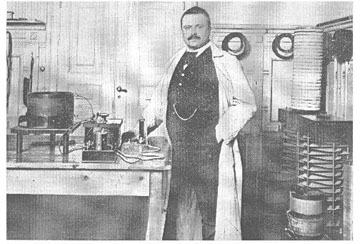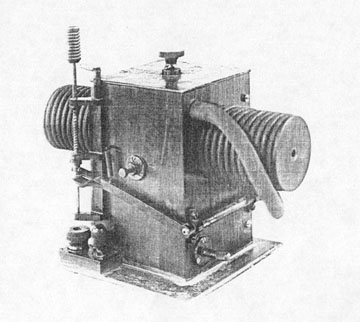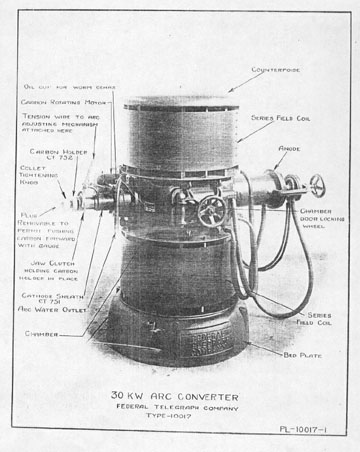This is the Jurassic Radio Section of
The Broadcast Archive
Maintained by:
Barry Mishkind - The Eclectic Engineer
Jurassic Telecommunications, Part III
Valdemar Poulsenís Canned Lightning
By Don Kimberlin
This is the third in a series titled Jurassic Telecommunications describing the late Victorian, non-electronic roots of modern telecommunications. Although the operational technologies have changed, the core technology and simple principles behind it have not. Most technology history fails to adequately chronicle those simple early methods and the gargantuan machines their developers often had to utilize.
Valdemar Poulsenís Canned Lightning
By Donald E. Kimberlin, NCE
February 5, 2000
By the late 1890ís Danish telephone engineer Valdemar Poulsen had completed his first major contribution to modern telecommunications, the Telegraphone. It provided the basis of todayís telephone answering machine, voice mail and magnetic recording of all types.

Valdemar Poulsen with his speech transmitter at Lyngby, Denmark in 1908
Arc Converter Technology Evolves
Poulsenís second great contribution to the telecommunications art had, like his first, multiple outgrowths. Once again, these were not immediately realized by his employers for the purpose he intended. Poulsen was known to be a reader of current literature of the time; thus he must have known of the efforts of other telephone developers like John Stone Stone. Stone had worked with Marconiís arc technology in an effort to produce multiple telephone circuits on a single wire circuit Ė in other words, attempted to create what would become known as "carrier telephony." However, Stone and others had been stymied by little understanding and practically no methods to control the bandwidth or frequency of the arc transmitter. In addition, the quality and hence articulation of the raw arc transmitter was so poor that any successful use of the arc for voice was not seen.
The need was thus rather clear A continuous "carrier" wave that could be controlled as to its transmission frequency would have to be found. How could this be done in that time a decade or more before electronics would even be conceived?
Duddellís "Singing Arc" Shows Poulsen the Way
In other literature, Poulsen read of a "singing arc" made by English electrical researcher Henry Duddell. Duddellís product caused an arc that made an audible tone, which Poulsen recognized as solving part of the problem by producing a continuous wave. Poulsen set out to increase the Duddell arcís output frequency up to the supersonic range and beyond. Poulsen hoped, by this means, to produce a telephone "carrier" system and perhaps also, to be able to launch its signals with antennae between the numerous islands of Denmark, to extend his employerís telephone network rapidly and economically. (One might also note that using radio as a first, most economical means of expanding a telecommunications transmission network has been a prime technique ever since that time.)
The simple but awkward techniques available at the time required methods that would probably be declared health hazards today. The Poulsen arc had to be operated in an atmosphere of pure hydrogen gas. One molecule of oxygen would certainly have caused an explosion. Controlling the characteristics of the live arc required the arc be operated within a strong magnetic field. Production of the hydrogen was accomplished by dripping pure alcohol from a wick onto the arc, while the magnetic field was simply a matter of using brute electrical power to produce a very dense magnetic field.

The Original Poulsen Arc Converter Purchased by Cyril Elwell in 1908.
Working Model of Arc Converter Developed and Patented
By 1902, Poulsen completed working models of his "arc converter," as such devices are called and proceeded to obtain patents in several nations. His employers, however, chose not to adopt his proposal. As with his earlier Telegraphone, he set out to try commercializing it himself, meeting with the delays of skepticism so commonly found by radical innovation. Six years later of Poulsenís publicity reached the notice of an Australian-born graduate engineering student at Stanford in California named Cyril Elwell. In classic Horatio Alger entrepreneurial style of the time, Elwell traveled to Denmark, met Poulsen, made business arrangements, purchased some samples and went back to San Francisco to develop it further. After a couple of years of business start-up and re-start, Elwellís effort became the Federal Telegraph Company, with a business plan to build a string of radiotelegraph stations for public message telegram service on the Pacific coast of the United States.
Navy Applies Technology in WW-I
The U.S. Navy took its run with the telecommunications ball in World War I days by taking custody of many forms of foreign technology that had come to the States. Federal Telegraph and its Poulsen patent licenses were part of that takeover. Federal became the manufacturing plant for a number of Poulsen arc converters placed on board U.S. Navy ships. In parallel, British submarines began to carry Poulsen arc converters for radio transmitters with a unique problem. It turned out that tired sailors could drink almost any form of alcohol including that needed to operate the Poulsen arc radio transmitter, so a very vile-tasting form of alcohol had to be devised to keep the swabs from sidelining their radio transmitter while at sea!
The Sound of Music (Beginnings of KCBS)
Another action seemingly related to the Poulsen arc converter and Federal Radio at San Francisco appears to be the first regularly scheduled radio broadcasts beginning in the 1909-10 time frame from nearby San Jose. There, one "Doc" Herrold commenced broadcasts of records from his music store, with Mrs. Herrold filling the role of the first "disk jockey," although that colorful term had not yet evolved. Herrold merely told historians he used "an arc transmitter," but his proximity to Elwell, Federal, and San Francisco seems to beg the odds in favor of his transmitter having been a Poulsen arc converter. What else would have been adequate to transmitting music? KCBS in San Francisco can trace its broadcasting genealogy back through callsigns KQW, SJN, 6FX, 6XE and FN to "San Jose Calling," the simple name Herrold gave to his first transmissions from his store.
Similarly, Lee DeForest was an Elwell colleague who built occasional broadcast stations 2XG in New York and 6XC in San Francisco, neither of which survived into a regular radio broadcast station descendant, as did Herroldís.
Advantages of the Poulsen Arc
The advantage of the Poulsen arc in those early days was that it could produce rather narrowband CW signals for direct application to the antenna. The raw baseband arc of Marconi produced everything from DC to daylight, with its antenna being at best a rather poor filter trying to block unwanted emissions. It didnít do so very successfully in view of the limited ability of "filters" in that early era. Thus, while Marconi transmitter plants had to be in rather remote eras, with the construction coast of an entire mini-city and a steam-powered electric generator plant, a Poulsen transmitter could be located right in a populated area that had personnel amenities and commercial electric power at hand.
The Poulsen arc converter could also produce generally higher fundamental frequencies than a baseband arc. They could thus reduce crowding in that era of almost anything called "radio" being less than 100 kiloHertz. In any event, they were more pleasant to listen to than the baseband arc, since they produced an almost pure carrier with a tone superimposed on it. The rendition of dots and dashes was thus a series of long and short tone bursts, something that could not be produced in the receiver in that time before any sort of local oscillator was available.
There was even one sort of rudimentary security element to use of Poulsen arc. It really could not be keyed on and off; rather, it had to be shifted in frequency, with the receiver tuning in only the wanted, or "forward" bursts. The "back wave," as it was called, was a poor image of the transmission; something bound to confuse any interloper who happened to tune it in and hear undecipherable bits of what seemed like Morse code.

A 30KW Arc Converter as typically made by Federal Radiotelegraph at San Francisco
Post War Development and ITTís Interests
At the end of the World War I era, the Poulsen technology was returned to Federal, which became more of a manufacturing and development company. Federal ultimately sold its radiotelegram operations to Mackay Radio, while its ultimate developments of Poulsen technology grew to gargantuan power levels of 350 kilowatts and even one megawatt for monstrous military fixed radio transmitter plants that require a later story to describe in detail. Federalís manufacturing operation eventually became part of ITT, with a long history of military radio development including many early forward-scatter radio transmitters.
Want to know more?
Here are some websites with information about Valdemar Poulsenís arc converter radio transmitters
http://www.sfmuseum.org/hist/poulsen.html
http://www.ipass.net/~whitetho/1908poul.htm
http://shell3.ba.best.com/~sfmuseum/hist/poulsen.html
http://www.asb.com/usr/w2g3zfj/lusit.htm
Don Kimberlin has written many articles about his experiences over the years, as well as those who were the pioneers in the telecommunications and broadcast industries.